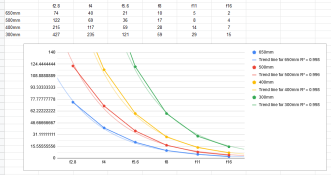I've been experimenting building my own light meter for darkroom printing. Idea is to get the time to a "ballpark" and maybe reduce one test strip in the process. I've been using digital light sensor which should have "light ranges from 188 uLux up to 88,000 Lux".
For example on my Fujimoto G70 on f2.8 aperture on 50mm nikkor lens, distance 450mm, I get lux values ranging from 0.066 to 0.8 lux.
However I'm struggling how to process this information. If I convert this information to EV and assume paper "film" ISO is about 8, I get totally wrong exposure times. Let's just throw that the EV is -2 at that 0.6 lux. That gives 30 seconds exposure time on f2.8 at film ISO 100. Multiply that to whatever "paper ISO" you want and you end up to many minutes exposure time, which is totally wrong.
Is there a problem that I'm measuring illuminance and I should calculate luminance some how?
Any insights how to use lux meter for darkroom printing would be really appreciated
Datasheet for the sensor I'm using: https://cdn-shop.adafruit.com/datasheets/TSL25911_Datasheet_EN_v1.pdf
For example on my Fujimoto G70 on f2.8 aperture on 50mm nikkor lens, distance 450mm, I get lux values ranging from 0.066 to 0.8 lux.
However I'm struggling how to process this information. If I convert this information to EV and assume paper "film" ISO is about 8, I get totally wrong exposure times. Let's just throw that the EV is -2 at that 0.6 lux. That gives 30 seconds exposure time on f2.8 at film ISO 100. Multiply that to whatever "paper ISO" you want and you end up to many minutes exposure time, which is totally wrong.
Is there a problem that I'm measuring illuminance and I should calculate luminance some how?
Any insights how to use lux meter for darkroom printing would be really appreciated

Datasheet for the sensor I'm using: https://cdn-shop.adafruit.com/datasheets/TSL25911_Datasheet_EN_v1.pdf











